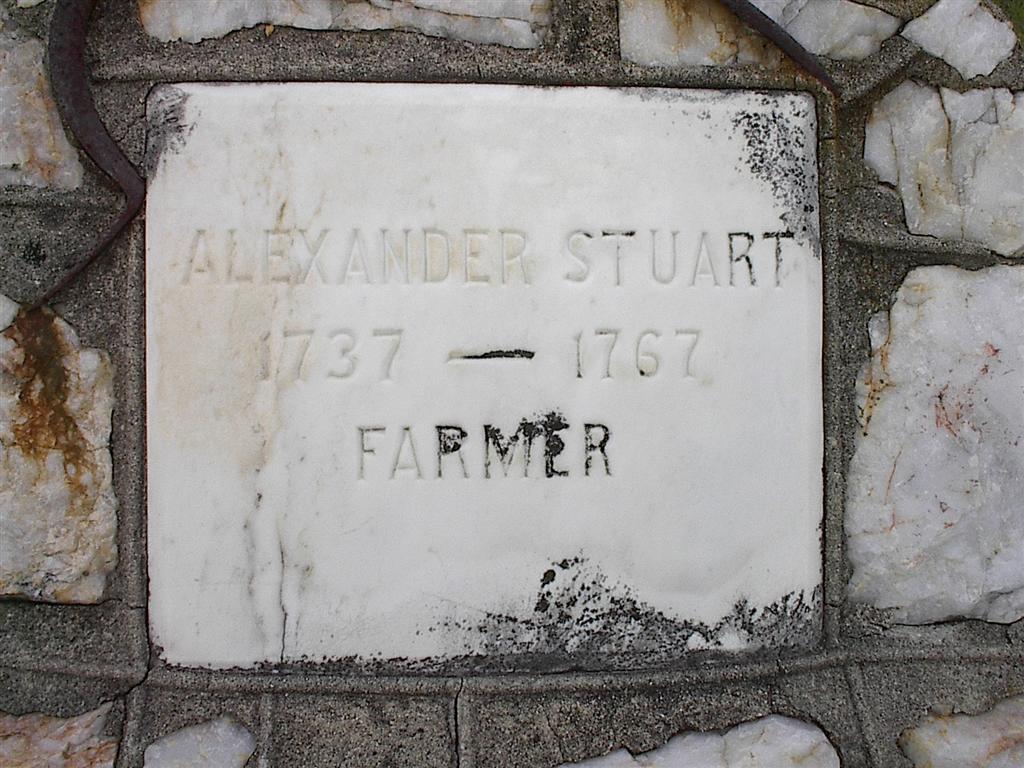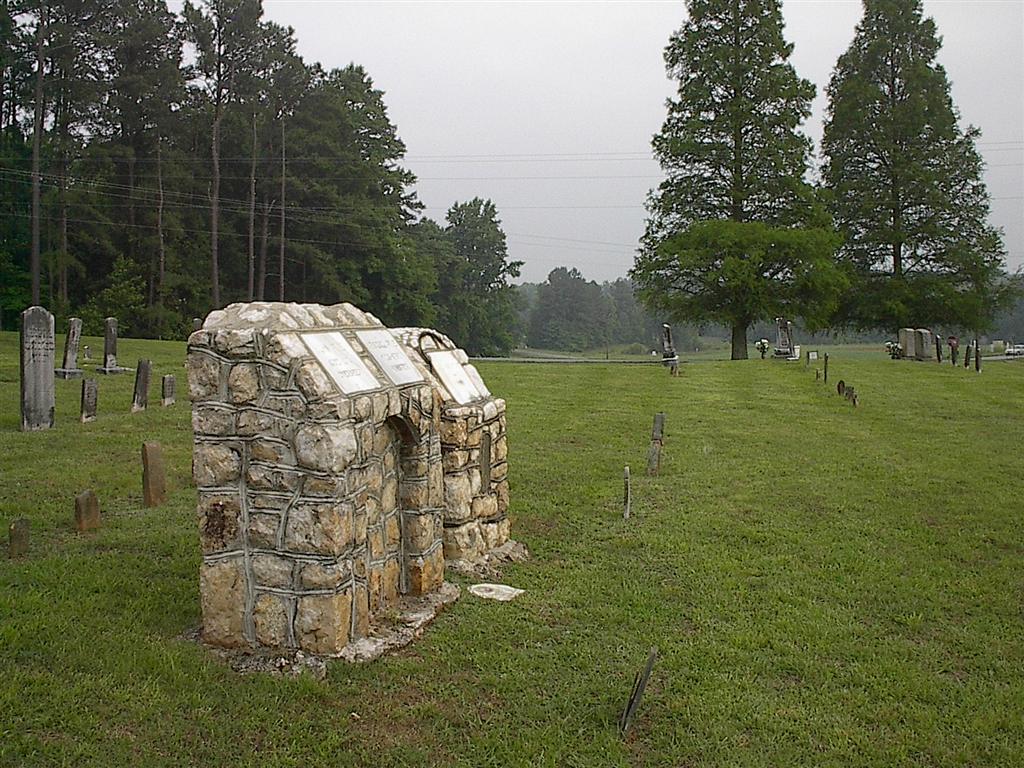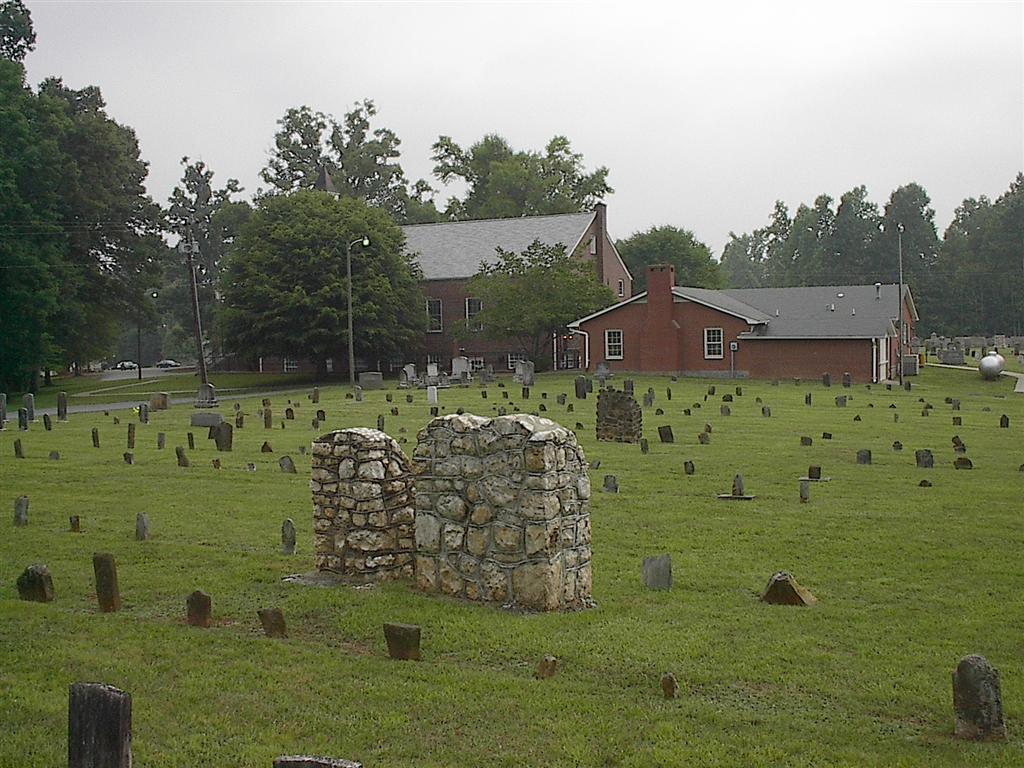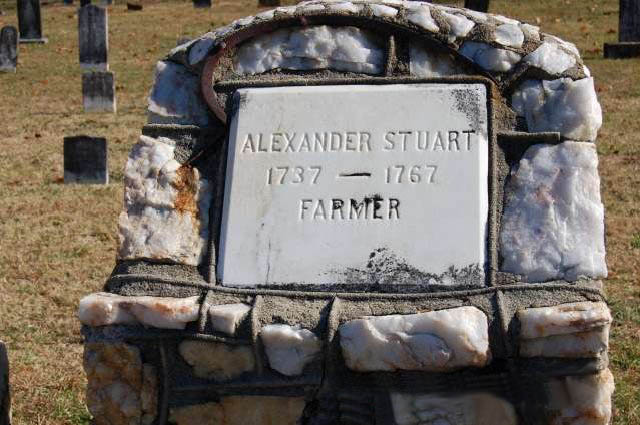Elizabeth remarried in 1768 to John Doan. My understanding he is probably not buried here but the memorial for him was.
CENTENNIAL HISTORY OF ALAMANCE COUNTY
In the year 1927, the Cane Creek Friends erected a monument to commemorate these pioneering days, and to honor one Alexander Stuart, one of the first immigrants to arrive here. The monument was placed in the Cane Creek church cemetery.
"In selecting one of the early settlers of the community to honor with a monument," wrote a local newspaperman, "the Cane Creek Memorial Association picked out a man whose chief claim to immortality lies in the fact that he was an honest hard working farmer . . . the first time in the entire South that a monument has been erected to a farmer simply because he was a farmer."
Leaving his family behind with friends, the early pioneer set out from Pennsylvania on horseback to seek a new home. He crossed the beautiful Cumberland and Shenandoah Valleys in early spring. Here he found a few Irish families settled, but they informed him that the Shawnee Indians were on the warpath and advised that he go farther southward. Beyond Virginia the signs of civilization decreased. Often the horse and its rider must swim a river or a creek which offered no fording place, and the trail became almost invisible.
With good weather, the Pennsylvanian reached North Carolina in less than one month. There were only a few secluded cabins in this country; yet there seemed an almost boundless natural wealth 3/4 virgin forest, good land, abundant water. Indeed, this was the place he sought! After selecting the tract he liked best, the pioneer sent for the land agent who held a patent or title to the property. The tract was surveyed and arrangements were made for a deed to be ready when the new owner returned with his family in autumn.
By this time word had spread through the countryside, and a group of "neighbors" left their homes miles away and came to help the new settler clear his fields, plant his crops, build his fences and raise his log home. The frontiersman was usually glad that a new family had come to make their home in the wilderness, bringing news of the outside world and offering a helping hand for the tasks which one family could not do alone. When the cabin was completed, the new settler left its care to these "neighbors" and climbed into his saddle for the journey northward.
In Pennsylvania many things had to be done in preparation for the trek to Carolina. The family sold everything they could not carry with them, and purchased three or four strong horses, or perhaps two yoke of oxen, and a heavy but commodious wagon. Into the wagon went every available article for the farm and home, leaving Just enough space for the women and small children and the family bedding. Behind the wagon a milch cow or two was tethered to the axle. The elder children would drive a small flock of sheep and a few hogs. All of these things were necessities, for there was no room for the luxuries which the family had possessed. When all preparations were completed, the departing family gathered for a last time in the village meeting house to receive the best wishes and the prayers of those whom they were leaving some perhaps forever.
Avoiding the hazardous stretches of the Blue Ridge mountains, the little caravan wound its way along the "Lower Trail" or Trading Path. Deep ruts in the road slowed the wagon and when it rained the road became impassable for several days. At night after the family had made camp, the children gathered around the glowing camp fires with excitement and adventure in their eyes, and their father told them stories of the wonderful place to which they were going. When the fire had burned low, the family would lie beneath the stars and dream of the promised land.
Some food they had brought with them, ham and tongue, chocolate, tea and coffee, and salt. Johnny-cake was baked over the evening campfire. For breakfast there was thick mush made from corn meal. Occasionally a little meat could be bought from a farmer who lived beside the road; and when there was no good pasture, the Journey halted while oats were threshed at some farm so they might buy some for the horses.
These were hard-working, simple, thrifty people. On weekdays they averaged ten miles a day, but on the Sabbath they stopped the wagon and spent the day in rest and thanksgiving. Only with strong faith could they endure the hardships which lay before them.
Late in August the wagon rolled across the ford on Haw River and soon arrived at the sturdy little cabin which was its destination. Much work now faced them. The cabin was soon swept and scrubbed and filled with the few items of furniture which had been brought on the long trip. Every member of the family busied himself or herself with the task of turning the wilderness into a home. the pioneer home
The cabin of the small farmer was not sufficiently large to contain much furniture, nor were there servants to care for it, so the family possessed only a few useful pieces. A chest, a table, a few beds and a stool or two completed the furnishings. Working with his nearest neighbor who owned an adz or crosscut saw, the pioneer felled a fine walnut or poplar tree and laboriously sawed it into planks. Put together with wooden pegs or notched to fit at the corners, in the place of scarce iron nails, these planks made a crude but serviceable piece of furniture. As soon as the region became more settled, some industrious person usually built a dam and set up a saw mill driven by water power.
Elizabeth remarried in 1768 to John Doan. My understanding he is probably not buried here but the memorial for him was.
CENTENNIAL HISTORY OF ALAMANCE COUNTY
In the year 1927, the Cane Creek Friends erected a monument to commemorate these pioneering days, and to honor one Alexander Stuart, one of the first immigrants to arrive here. The monument was placed in the Cane Creek church cemetery.
"In selecting one of the early settlers of the community to honor with a monument," wrote a local newspaperman, "the Cane Creek Memorial Association picked out a man whose chief claim to immortality lies in the fact that he was an honest hard working farmer . . . the first time in the entire South that a monument has been erected to a farmer simply because he was a farmer."
Leaving his family behind with friends, the early pioneer set out from Pennsylvania on horseback to seek a new home. He crossed the beautiful Cumberland and Shenandoah Valleys in early spring. Here he found a few Irish families settled, but they informed him that the Shawnee Indians were on the warpath and advised that he go farther southward. Beyond Virginia the signs of civilization decreased. Often the horse and its rider must swim a river or a creek which offered no fording place, and the trail became almost invisible.
With good weather, the Pennsylvanian reached North Carolina in less than one month. There were only a few secluded cabins in this country; yet there seemed an almost boundless natural wealth 3/4 virgin forest, good land, abundant water. Indeed, this was the place he sought! After selecting the tract he liked best, the pioneer sent for the land agent who held a patent or title to the property. The tract was surveyed and arrangements were made for a deed to be ready when the new owner returned with his family in autumn.
By this time word had spread through the countryside, and a group of "neighbors" left their homes miles away and came to help the new settler clear his fields, plant his crops, build his fences and raise his log home. The frontiersman was usually glad that a new family had come to make their home in the wilderness, bringing news of the outside world and offering a helping hand for the tasks which one family could not do alone. When the cabin was completed, the new settler left its care to these "neighbors" and climbed into his saddle for the journey northward.
In Pennsylvania many things had to be done in preparation for the trek to Carolina. The family sold everything they could not carry with them, and purchased three or four strong horses, or perhaps two yoke of oxen, and a heavy but commodious wagon. Into the wagon went every available article for the farm and home, leaving Just enough space for the women and small children and the family bedding. Behind the wagon a milch cow or two was tethered to the axle. The elder children would drive a small flock of sheep and a few hogs. All of these things were necessities, for there was no room for the luxuries which the family had possessed. When all preparations were completed, the departing family gathered for a last time in the village meeting house to receive the best wishes and the prayers of those whom they were leaving some perhaps forever.
Avoiding the hazardous stretches of the Blue Ridge mountains, the little caravan wound its way along the "Lower Trail" or Trading Path. Deep ruts in the road slowed the wagon and when it rained the road became impassable for several days. At night after the family had made camp, the children gathered around the glowing camp fires with excitement and adventure in their eyes, and their father told them stories of the wonderful place to which they were going. When the fire had burned low, the family would lie beneath the stars and dream of the promised land.
Some food they had brought with them, ham and tongue, chocolate, tea and coffee, and salt. Johnny-cake was baked over the evening campfire. For breakfast there was thick mush made from corn meal. Occasionally a little meat could be bought from a farmer who lived beside the road; and when there was no good pasture, the Journey halted while oats were threshed at some farm so they might buy some for the horses.
These were hard-working, simple, thrifty people. On weekdays they averaged ten miles a day, but on the Sabbath they stopped the wagon and spent the day in rest and thanksgiving. Only with strong faith could they endure the hardships which lay before them.
Late in August the wagon rolled across the ford on Haw River and soon arrived at the sturdy little cabin which was its destination. Much work now faced them. The cabin was soon swept and scrubbed and filled with the few items of furniture which had been brought on the long trip. Every member of the family busied himself or herself with the task of turning the wilderness into a home. the pioneer home
The cabin of the small farmer was not sufficiently large to contain much furniture, nor were there servants to care for it, so the family possessed only a few useful pieces. A chest, a table, a few beds and a stool or two completed the furnishings. Working with his nearest neighbor who owned an adz or crosscut saw, the pioneer felled a fine walnut or poplar tree and laboriously sawed it into planks. Put together with wooden pegs or notched to fit at the corners, in the place of scarce iron nails, these planks made a crude but serviceable piece of furniture. As soon as the region became more settled, some industrious person usually built a dam and set up a saw mill driven by water power.
Bio by: Patty Shaw
Family Members
Advertisement
Records on Ancestry
Sponsored by Ancestry
Advertisement
















